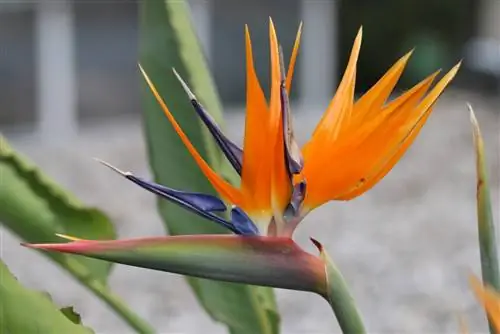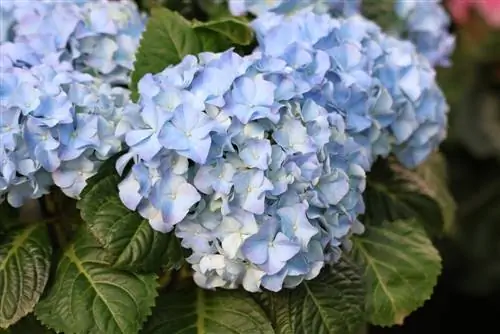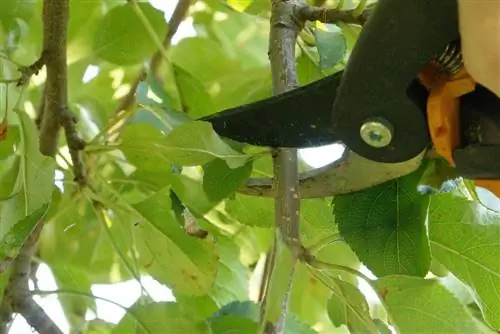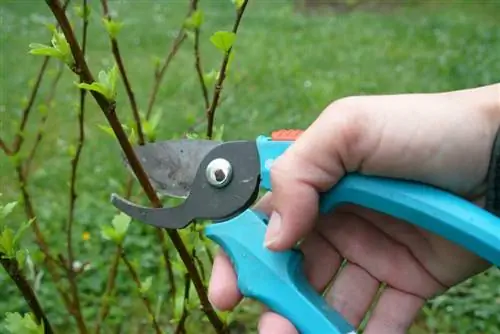- Author admin [email protected].
- Public 2023-12-17 03:39.
- Last modified 2025-06-01 06:48.
The Strelitzia is native to South Africa and the Canary Islands. The flower resembles an exotic bird's head, so other well-known names include "bird of paradise flower" and "parrot flower". You can admire the flowers of the Strelizia almost all year round.
These exotic flowers usually bloom for more than four weeks. Since the three petals of the flower open one after the other, you benefit from a long flowering period. The large and leathery leaves of the parrot flower resemble banana plants. About four years after sowing, the Strelizia blooms for the first time.
Location for Strelicia
In our latitudes, Strelitzia cannot grow as an outdoor plant. Due to the climatic conditions, the bird of paradise flower is sown in a bucket. In winter you should definitely put the plant indoors. As soon as the temperatures drop below 10 °C at night, the Strelizia must be brought indoors. The Strelizia can only be put out again from the second half of May. There is a chance that the parrot flower will remain in a bright and airy location until the end of September. It also needs a bright location in the house. The room temperature should be 10 to 15 °C. If conditions are very good, flowering begins in December. The Strelizia particularly appreciates a location that is very bright and where it benefits from several hours of daily sunlight. In weak, poor lighting conditions, the Strelitzia cannot produce flowers.
Location tips
- bright place with several hours of sunlight
- cool place in winter with temperatures of 10 to 15 °C
- avoid weak, poor lighting conditions
Strelizia - care and husbandry
When watering, you should be careful to avoid waterlogging. Nevertheless, it is important to provide larger plants with enough water in summer. They lose a lot of moisture through their leaves. Since the bird of paradise flower is in a cooler location in winter, it requires less water. The Strelitzia is watered abundantly. After watering, it is necessary to remove excess water from the saucer. Under no circumstances should the parrot flower remain in the water. It is also advisable to allow the top layer of soil to dry a little before watering again. The Strelizia requires a period of rest from winter to spring. During this period you should only water the plant very sparingly. It is important to ensure that the pot balls do not dry out. In addition, the Strelizia should be in a cool location to ensure early flowering. The plant should be treated with a little liquid fertilizer every 14 days. Fertilization is stopped during the rest phase. The Strelitzia only needs to be repotted every three years. Otherwise, it is sufficient to replace the top layer of soil in the pot. You should be particularly careful when repotting as the delicate roots can easily break.
Care tips
- Avoid waterlogging when watering
- fertilize every 14 days
- Repotting required every three years
Pests
Sometimes it happens that the strelizia is attacked by scale insects. On the undersides of leaves and stems there are scale insects, which are flat and 3-4 mm long. Initially they are light brown to greenish. They later turn dark brown. The waxy shields are already empty at this point and there are no longer any larvae to be found underneath. After some time, the leaves of the plant fall off. There are some environmentally friendly measures to combat these pests. It is possible to scrape off the scale insects. The undersides of the leaves are then treated with an oil-based agent. The oil film serves to suffocate the scale insects. If you discover the pests in time, scraping is sufficient. This makes it possible to save yourself the hassle of brushing or spraying. Therefore, you should always keep an eye on Strelicia in its winter quarters in order to be able to intervene immediately when the pest infestation begins. The sticky honeydew, which comes from excess sugar, is wiped off with a damp cloth. Otherwise there is a possibility that harmful fungi will settle here and further weaken the plant. To prevent pest infestation, high humidity is required. This measure is very effective and also benefits your own he alth at the same time.
Pest Control Tips
- Scrape off scale insects
- Treat with oil-based products if necessary
- Wipe honeydew
- Provide enough fresh air as prevention
Propagation of Strelizia

The Strelitzia can be propagated by division in late spring. For this purpose, the parrot flower must be removed from the pot. A secondary shoot with a few roots and three leaves is then carefully separated. This part of the plant is potted in a planter filled with compost soil. This pot should be placed in a bright, warm place without direct sunlight for around 5 weeks. The new plant is not fertilized during this time. You should also make sure to only water a little. The soil must dry out again and again between waterings. As soon as the growing period is over, the plant already has well-developed roots. This offspring can be cultivated like an adult specimen.
Propagation Tips
- Carefully remove the plant from the pot
- Separate part of the plant
- plant in a pot and place in a place without direct sunlight for about 5 weeks
- then cultivate as an adult specimen
The Strelizia is a very attractive plant from the banana family and exudes a tropical flair in the garden, on the terrace, on the balcony or in the winter garden. The bird of paradise flower loves sufficient sunlight and is not hardy. Since the plant is prone to pest infestation by scale insects, sufficient humidity is particularly important. Strelizia can be propagated by dividing the mother plant.
What you should know about Strelizia in brief
- Strelizia come from southern Africa, but are now also widespread in the Canary Islands.
- They were named in honor of Princess Charlotte of Mecklenburg-Strelitz, the wife of the English King George III.
- The plant was first brought from Africa to England in the 18th century.
- In 1818 the first Strelizia came from England to Germany, where it bloomed four years later.
Strelizia are extremely robust and not very demanding to care for; they require a warm, sunny or partially shaded location as well as permeable, nutrient-rich soil. Since a lot of liquid evaporates through the large leaves, the plants need plenty of water in spring and summer. Liquid fertilizer should also be added to the irrigation water once a week, but at least every 14 days. The soil should be kept moist, but the top layer of soil should periodically dry out. In winter the plants need less water and they also need a bright, cool place of no more than 15 ºC.
Strelizia not blooming?
Strelizia only bloom when they are three to four years old at the earliest, rather later. So you don't have to worry about it beforehand. Until then, the plant needs as much sun as possible in summer. It is best placed outdoors. However, it is important that she gets used to the sun slowly, otherwise she will get sunburnt. Two to three weeks of getting used to it are usually enough. Then you should protect them from the blazing midday sun for a while.
It is important to find the right size when pouring. The root ball should never dry out, but the plant should not be overwatered either. Standing water must be avoided at all costs, otherwise the roots will rot rather quickly. It is best not to place a saucer under the planter. It is also crucial for flower formation that the container for the Strelizia is not too large. As long as the plant can form roots, it invests its energy there and not in the formation of flowers.
Strelicias usually bloom indoors in early spring. They like a cooler location in winter, but it needs to be very bright. It is watered much more sparingly, but never let it dry out completely!
Rolled up leaves - what to do?
Rolled leaves almost always indicate a disturbed water balance. It doesn't matter whether you watered too much or too little. Of course, parasites can also be the reason for the leaves curling. It's best to first examine the leaves for pests. If you don't find anything there, you should take the perennial out of the pot and take a look at the roots. He althy roots look firm and plump. Black roots usually don't mean anything good. You can still try to save the plant. Repot, removing some broken roots. Change watering behavior!
Strelizia species
There are five types. All are native to the eastern coast of South Africa, up to Mozambique and the eastern highlands of Zimbabwe.
- White Strelizia - grows up to 10 meters high; the flowers are not colorful, but white to cream-colored; closely resembles a banana tree; blooms all year round, a single inflorescence per plant; become very rare in their homeland
- Mountain Strelizia - up to 6 meters high; also acts like a banana plant; blooms all year round, single inflorescence; very beautiful colored flowers; thrives in cool, moist mountain forests; not suitable as a container plant
- Bulrush Strelizia - rather rare species; can be grown yourself, seeds are available commercially
- Natal or tree strelizia - up to 12 meters high, very similar to a banana plant; blooms all year round, flower color not so intense; originally grows in dune vegetation; drought tolerant; copes well with s alty coastal winds; Does not tolerate severe frost
- Bird of Paradise or Royal Strelizia - as described above






